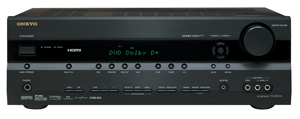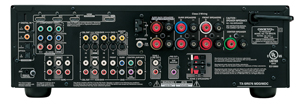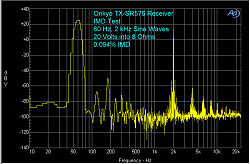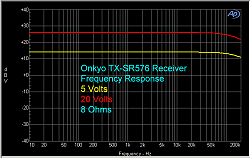Introduction
Last year Onkyo introduced a truly stunning product, the TX-SR605, which offered HDMI 1.3 inputs, HD audio processing and a host of other advanced features at the amazing price point of $599. As 2007 has moved to 2008, Onkyo has now introduced their TX-SRxx6 series receivers and a new model, the Onkyo TX-SR576, that looks to move some of the TX-SR605’s novel features to an even lower $479 price point
Specifications
- Design: 7.1 A/V Receiver
- Codecs: Dolby Digital Plus, Dolby Digital EX, Dolby Pro Logic IIx, DTS (ES, NEO:6, 96/24)
- Three HDMI Inputs, One Output – 1080p Repeater
- Audyssey 2EQ
- Power Output: 80 Watts RMS x 7
- MFR: 5 Hz–100 kHz (+1 dB, -3 dB)
- THD: 0.08% (20 Hz-20 kHz)
- Dimensions: 5.9″ H x 17.1″ W x 14.9″ D
- Weight: 21.6 Pounds
- MSRP: $479 USA
- Onkyo
Â
Â
Design
Weighing in at 21.6 lbs and measuring 14 15/16″ deep and 5 7/8″ tall, the Onkyo TX-SR576 is not a particularly heavy or large receiver. The basic black front panel of the TX-SR576 is well laid out with a large volume knob and solid feeling button controls. The front panel of the Onkyo has a wealth of control options that allow one to operate the receiver entirely from the front panel. One area of the front panel where I can not be so positive is the display. The main message area takes up most of the display space and it provides reasonably legible feedback on input and volume information. It also shows surround modes and setup information when you are adjusting those settings. The real issue is with the listening mode, format and audio input indicators. The icons are very small and almost impossible to read at any reasonable distance. Their arrangement is not particularly logical and their meanings are inadequately explained in the manual.
The first thing you notice about the Onkyo’s back panel is the trio of HDMI 1.3a repeater inputs. Older input devices are also well accommodated with two coaxial, two optical and two component video inputs. There are also radio antenna inputs and a 7.1 channel analog input. Speaker terminals are the familiar 2-way variety that can accommodate either bare wires or banana plugs and are color coded to make setup easier. Finally, there is both a line level and an amplified “Zone 2” audio output. Overall, the back panel of the Onkyo TX-SR576 is logically arranged with distinct input blocks that should make setup very easy.
Â
Â
Processing
The Onkyo TX-SR576 offers all of the low-res codecs for both Dolby and DTS. In addition the TX-SR576 adds Dolby Digital Plus decoding should you have a new source that cannot decode this format internally. The TX-SR576 can also handle high-res multi-channel PCM over its HDMI input, but it will not decode Dolby TrueHD or DTS-HD Master Audio in Blu-ray disc soundtracks.
The Onkyo has a well implemented Mono mode that allows you to select from a stereo mix which channel or channels are output. Additional modes on the TX-SR576 are a generic THX Re-EQ mode called “CinemaFILTER”, a MP3 enhancer called “Music Optimizer”, a “Direct” mode that bypasses all of the Onkyo’s processing and a host of generic DSP modes with names like “Unplugged” and “Orchestra”.
The TX-SR576 offers great flexibility in fine tuning volume control and surround modes on an input by input basis. The IntelliVolume feature allows for a relative volume trim on each input of up 12 dB in 1 dB steps. Additionally, one can define a default surround mode for each input depending on the input type. The Onkyo offers a “lip sync” delay adjustable in 20 ms increments from 0 to 100 ms or, if you have a compatible display, there is an HDMI lip sync function that will do this automatically. The TX-SR576 also features the Audyssey 2EQ system for room equalization. Audyssey is my current favorite room eq system and is a great addition to a budget receiver like this.
Remote Control
The Onkyo’s remote is an attractive and efficient design. The remote is a good compromise between complexity and simplicity and I found it very usable. Through a mix of color and blocking, the function of buttons on the remote is easy to identify. The hard rubber buttons have a nice feel and the remote itself is comfortable to hold. I also like the gloss black finish which gives the remote a more premium look.

Â
Â
Â
Â
Â
Â
Â
Â
Â
Â
Â
Â
Â
Â
Â
Â
Â
Programming the remote is straight forward using the included list of device codes. I was impressed with the extensive list of remote codes, which included codes for Vizio and Oppo devices as well. Once programmed, the remote worked well for controlling my HD DVD player and TV, but the button mapping for my Oppo DVD player was a bit off. The remote also has a volume punch through for the Onkyo regardless of what device mode one is in. Surround field selection is handled by cycling through options with the respective “movie/tv”, “music”, “game” or “stereo” button. It would have been nice had Onkyo maintained the functionality of these surround field buttons regardless of the remote’s device mode . Unfortunately, the remote is not learning capable.
Performance
Setting up the Onkyo TX-SR576 is relatively straight forward despite having to do it strictly from the front panel (this model does not have an onscreen display). One simply plugs in the included setup microphone and the Onkyo takes care of the rest of the process. The automated setup was spot on with levels and distances, but it set the subwoofer crossover too high for my taste at 150 Hz. After that one needs to dive into the setup menus to assign the HDMI, component video and digital inputs to their respective sources. The Onkyo is very flexible in this respect allowing the user to assign these inputs to any of its six source options.
From Xbox 360 to HD DVD to CD, the Onkyo easily handled all of the material I threw at it. A big, percussive and dynamic soundtrack and a well written story make Iron Man one of my current favorite test discs. The TX-SR576 handled the movie well, creating a detailed and powerful surround experience. The TX-SR576 was equally impressive with a multichannel PCM input from the HD DVD of The Bourne Ultimatum. The Onkyo also does a nice job with CDs where you can either go with an unprocessed “direct” mode or “stereo” where Audyssey and bass management are engaged. I preferred “stereo” on everything from sparse acoustic arrangements on the Kings of Convenience’s Riot on an Empty Street to dense electronic music on Bloc Party’s new album, Intimacy. Finally, the Onkyo supported an immersive sound experience during my gaming on the Xbox 360.
On the Bench (JEJ)
Measurements were made with two channels driven. Distortion bandwidth was 80 kHz.
IMD was 0.094% at 20 volts into 8 ohms (50 watts RMS).
THD+N vs. Frequency test results for 8 ohms and 4 ohms were fair. This receiver could probably drive 4 ohm loads, but with limited use of the volume control.
For THD+N vs. Power, at 8 ohms, distortion was low until 78 watts, then rose rapidly to clipping at 105 watts. At 4 ohms, it stayed low to 100 watts, then rose to clipping at 160 watts. This was with two channels being driven.
Frequency response was 0 Hz to 80 kHz, – 1 dB. At 4 ohms, the extreme end of the response dipped a bit, with overall response down 4 dB at 200 kHz.
Â
Â
Conclusions
The Onkyo TX-SR576 is a fine receiver and solid value at $479. It was easy to setup, easy to use and consistently delivered a strong audio performance. In the context of its direct competition, the Onkyo TX-SR576 is a very compelling product, offering a competitive feature set and solid performance. However, the strongest competitor for this receiver doesn’t come from another brand, but from within Onkyo’s own product line. For an extra $120, the TX-SR606 gives the user some very useful video processing, another HDMI input (for a total of four), full support for the Dolby and DTS HD audio codecs and an on screen display. If you have three or fewer sources and you can run them all on HDMI then I would say the TX-SR576 offers the better value, but if your system is more complex, the extra $120 for the for the TX-SR606 will be money well spent.











